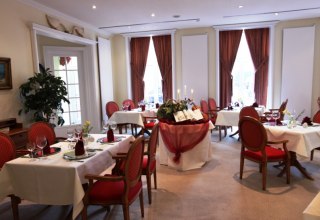Comfortable furnishings, all rooms with kitchen and bathroom, rooms also for rent as a vacation apartment.
Long-term rental possible, children 4-12 years 12 EUR/night, convenient connection to A 24
Comfortable furnishings, all rooms with kitchen and bathroom, rooms also for rent as a vacation apartment.
Long-term rental possible, children 4-12 years 12 EUR/night, convenient connection to A 24
Your destination:
Pension Blumeneck
Neustädter Straße 43
19288 Ludwigslust

Nestled in the charming landscape of the Thousand Lakes Mecklenburg, on the edge of the protected landscape area Lewitz, a wonderful stay awaits you in our 4-star hotel. The castle inspires with baroque splendor, 1,600 m² of lush stucco work and 32 chimneys richly decorated with rosettes, cornices and figures. With branch office of the registry office for a dream wedding in the castle.

"Island" of relaxation and tranquility. Round plank café with a magnificent view over the boat harbor. Fishing possibility directly at the pitch or nearby. Large lawn for relaxing and sunbathing. A well-kept green area invites you to look and linger.

The oldest preserved fortress in Mecklenburg stands in Neustadt-Glewe. It is one of the best preserved castles in Mecklenburg and can be visited. At the castle, there is a museum that is well worth seeing, as well as a restaurant and a tourist information office.

The BUGA 2009 in Schwerin and a climate forest for our environment - what could be more natural than combining the major event of a Federal Horticultural Show with the reforestation of a new forest area! One day after the start of the BUGA in Schwerin, this sixth 1.7-hectare climate forest in Mecklenburg-Vorpommern was opened with a planting event in Neuhof on April 24, 2009.

The duke's half-timbered orangery, built around 1780, is now a unique event location with its own brewery, just 200 meters from Ludwigslust's baroque palace.

The magnificent Ludwigslust Palace, situated in a spacious park with avenues, cascades, canals and water jumps, is the center of the late Baroque town complex. In the castle's museum, the restored rooms shine in courtly splendor and transport visitors back in time. In the hunting hall of the castle there is a café with a spacious terrace overlooking the castle park.

The park is temporarily completely closed due to a tree fall. Measures are currently underway to restore traffic safety along the main paths. The castle museum, café and the lawn parterre are accessible.

Our cafe is located on the first floor of the beautiful castle. The large terrace offers a great view of the castle park.

The bright, thatched half-timbered house in the palace park was built as the summer residence of Duchess Luise at the end of the 18th century in Ludwigslust Palace Park.

the kramserei - an over 170 year old hall farmhouse in the Griesen area - offers creative freedom in many ways: pottery, candle casting, soap boiling, willow weaving are courses in traditional crafts. In addition, there is a lot to experience live in the hall and on the park-like property.

The world of legends in the Lewitz is teeming with dragons, mythical creatures and all kinds of secrets from the history of Germany's largest meadow landscape. There are a total of 16 stations along the trail, each of which has a legend as its theme. Artists have created statues for each station, and the legend can be read on panels or accessed as a radio play via QR code. For children there are discovery tasks and information about the forest and nature is conveyed in a playful way. Start and finish is the hunting lodge Friedrichsmoor the path is suitable for hikers and cyclists.

Our hotel with restaurant is quietly located and not far from Ludwigslust Castle and the train station.

The hotel is located in a central, quiet location in the historic baroque town of Ludwigslust. It is a very nice house with style, classic and comfort of a four-star hotel. The restaurant currently offers a pick-up service and recipe boxes for delicious Christmas dishes to take home.

Would you like to purchase high-quality, handcrafted products from the region? Then visit one of the Biosphere Shelves in the UNESCO Biosphere Reserve River Landscape Elbe MV e.V.! Products of the partners of the biosphere reserve are sold via the shelves. Join in - enjoy a piece of the region!

The perfect stop between Berlin and Hamburg is only 5 minutes away from the highway A24 (exit Wöbbelin). In the small community of Wöbbelin you will find our versatile adventure farm.